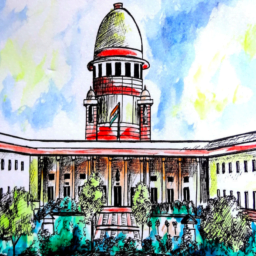INTRODUCTION
In May 2021, the Maratha reservation was struck down by the Supreme Court.[1] A five-judge Constitution Bench pronounced their decision and declared the law which aimed to provide reservation to the Maratha community of Maharashtra, as unconstitutional. The purpose of the law was to give reservations in educational institutions and government jobs.
BACKGROUND
Due to the rising demand for reservations in Maharashtra, an 11-member commission was set up, which was headed by Retired Justice N.G. Gaikwad and the commission recommended that the Marathas should get the reservation under Socially and Educationally Backward Class (SEBC).[2] But the commission had not mentioned the exact percentage of reservation that shall be granted and the decision to determine the reservation percentage was left to the discretion of the State government. In 2018, a bill was passed by the Maharashtra Assembly to give the reservation benefits to the Maratha community under the Maharashtra State Socially and Educational Backward Act.[3] The reservation given to the Maratha community was 16%.
The Bombay High Court in 2018, upheld the reservation but asked to reduce the percentage quota. The 16% quota was reduced to 12% for educational institutions and 13% for government jobs but, in 2020, the Supreme Court put a stay on the implementation of the reservation and referred the case to the Chief Justice of India for a larger bench.[4]
SUPREME COURT’S RULING
In May 2021, the Supreme Court struck down the law providing the reservation benefits to the Marathas of Maharashtra and declared the law unconstitutional. This decision was made by a five-judge bench of the Supreme Court.[5] It was held that the law, by giving reservation to the Maratha community, is violating Article 14 which deals with the right to equality, and Article 21 which talks about the due process of law. The law proposed to provide reservation benefits of 12% and 13% to educational institutions and government jobs, respectively. This law was breaching the 50% limit and there were apprehensions that an excessive increase in reservation could lead to caste rule and reduce the percentage of selections and appointments based on merit. The law granting reservation of 12% for education and 13% for jobs, had increased the overall reservation of the state to 64% and 65%, respectively.[6] Also, the appointments which were already made under the quota, after the Bombay High Court gave validation to the law would be considered as valid. But they will be provided with no further benefits.[7]
INDRA SAWHNEY JUDGEMENT
The Supreme Court declared the law, providing reservation to the Maratha community, unconstitutional and also refused to re-visit to the Indra Sawhney judgement. In the landmark judgement of Indra Sawhney v. Union of India[8], it was held that 50% shall be the limit for reservation and it should not be exceeded. It was held that “Reservation being an extreme form of protective measure should be confined to a minority of seats even though the constitution does not lay down any specific bar, the principle of balancing equality; reservation of any manner shall not exceed 50%”. The limit shall be exceeded only in some extraordinary or exceptional situations. The landmark judgement was held in 1992 by a nine-judge bench.[9] The court, through this judgment, had set the maximum limit for a reservation to 50% in education and jobs. The judgement also gave focus to the ‘creamy layer’ concept.[10]
POWER TO IDENTIFY SEBCs
Now, the states are deprived of their authority to identify the Socially and Educationally Backward Classes (SEBCs). In the judgement, it was held that there would be only a single list of Socially and Educationally Backward Class concerning each state and union territory of India and it would be notified by the President.[11] It was held that states can only make recommendations for inclusion or exclusion and any change shall be only made by the Parliament.
Also, the court has asked the National Commission for Backward Classes to fasten the process of recommendation of SEBCs. This would help the President to quickly publish the notification containing the list of SEBCs for states and union territories.
102ND AMENDMENT ACT, 2018
The five-judge bench upheld the constitutionality of the 102nd amendment act and held that it removed the power of the states to identify socially and educationally backward classes to grant them reservation.[12] The Amendment Act introduced Article 338B and Article 342A in the Indian Constitution. Article 338B provides to establish the National Commission for Backward Classes.[13] Article 342A gives powers to the President of India to specify the socially and educationally backward communities of a state.[14] It says that the power lies with the Parliament to include a community in the Central list of SEBCs to grant them reservation.[15]
CONCLUSION
Keeping in mind the rising demand for reservation by the Maratha community of Maharashtra, a commission headed by retired Justice NG Gaikwad was set up and it recommended giving the reservation benefits to the Maratha community of Maharashtra in educational institutions and government jobs.[16] The Maharashtra Assembly passed a bill that proposed 16% reservation in education and jobs. The Bombay High Court upheld the reservation but asked to change the quota percentage from 16% to 12% and 13% in education and jobs. The implementation was put on stay by the Supreme Court and was referred to a larger bench. It was held that the reservation was breaching the 50% limit, decided in the Indra Sawhney judgement, and hence was struck down and declared unconstitutional. Granting reservation for the upliftment of the backward communities is a necessary step but providing reservation above the fixed limit could lead to a state of caste rule and can reduce the number of appointments and selections based on merit. Hence, the law which aimed to provide reservation benefits in education and jobs to the Marathas of Maharashtra state was struck down by the Supreme Court of India. The law had passed through various stages but was finally declared unconstitutional as it was breaching the 50% limit for reservation decided in the landmark Indra Sawhney judgement.
Author(s) Name: Dhruv Soni (Symbiosis Law School, Noida)
References:
[1] Shubhangi Khapre, ‘Explained: How Marathas got reservation, and what happens now’ (Indian Express, 11 May 2021) <https://indianexpress.com/article/explained/explained-how-marathas-got-reservation-and-what-happens-now-7303056/> accessed 24 December 2021
[2] ‘Maratha Reservation Struck Down: SC’ (Drishti IAS, 6 May 2021) <https://www.drishtiias.com/daily-updates/daily-news-analysis/maratha-reservation-struck-down-sc> accessed 23 December 2021
[3] Ibid
[4] Supra Note 1
[5] Supra Note 2
[6] Supra Note 1
[7] Krishnadas Rajagopal, ‘Supreme Court declares Maratha quota law unconstitutional’ (The Hindu, 5 May 2021) <https://www.thehindu.com/news/national/sc-declares-maratha-quota-law-unconstitutional/article34487043.ece> accessed 23 December 2021
[8] Indra Sawhney v. Union of India, AIR 1993 SC 477
[9] Supra Note 7
[10] Supra Note 8
[11] Supra Note 2
[12] ‘102nd Amendment Act’ (BYJU’S) <https://byjus.com/free-ias-prep/102nd-amendment-act/> accessed 23 December 2021
[13] The Constitution of India, 1950, Art. 338B
[14] The Constitution of India, 1950, Art. 342A
[15] Supra Note 7
[16] Supra Note 1















